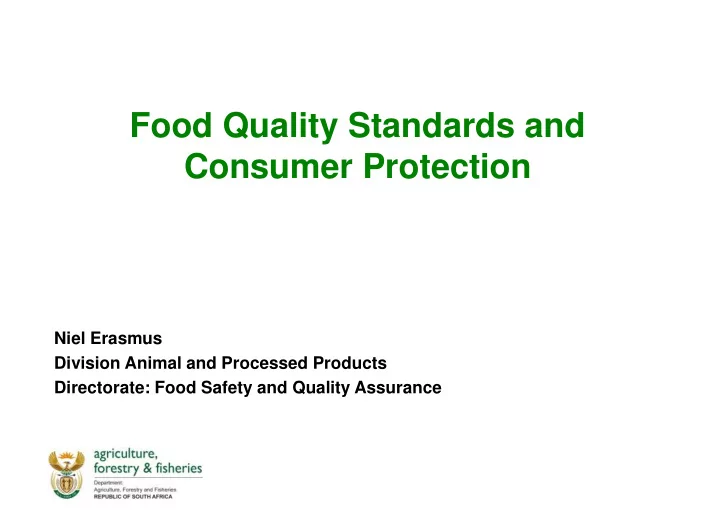

NATIONAL DEPARTMENT OF AGRICULTURE Food Quality Standards and Consumer Protection DIRECTORATE FOOD SAFETY & QUALITY ASSURANCE Niel Erasmus Division Animal and Processed Products Directorate: Food Safety and Quality Assurance
The Act THE AGRICULTURAL PRODUCT STANDARDS ACT, 1990 (Act No. 119 of 1990) Amended in 1998 Approved by Parliament 2
Legislation REGULATIONS Local (Imported products) Approved by Minister of Agriculture & STANDARDS AND REQUIREMENTS (Export) Approved by Executive Officer 3
Scope The regulations/standards and requirements are product specific-- Not general Covers a specific product or group of products Scope determined by the definitions or scope declaration 4
Responsibilities APS Act: Local market (imported) – only quality (all regulated products) Department of Health – food safety and health issues Export market – quality (all regulated products) and food safety and hygiene issues (only regulated plant products) 5
Contents Packing & Container requirements Labelling requirements Marking requirements Quality standards for classes or grades Food safety and hygiene requirements (export ) 6
Process of drafting legislation Determine need Set standard/regulation – agreement (Draft → Distribute for comments, Meetings, etc. → New draft) World Trade Organisation (WTO) notification (local) Ministerial approval/Executive Officer Publish 7
Regulated products Divisions: Vegetables and grain Fresh vegetables, grains and oilseeds, nuts Fruit and Flowers Fresh fruit, and flowers and ornamental foliage for export Animal and Processed Products 8
Animal and Processed products Honey (local) Mayonnaise & Salad Dressings (local) Red Meat (local) Vinegar (local) Edible Ices (local) Fat spreads (local) Table Olives (local) Honeybush (export) Apricot and Peach Kernels (export) Poultry Meat Eggs Dairy and Imitation Dairy Products Rooibos Canned Fruit Canned Vegetables Canned Pasta Canned Mushrooms Dried Fruit Frozen Fruit & Frozen Vegetables Jam, Jelly and Marmalade 9
Grading and Classification Degrees of quality Choice Grade dried fruit Standard Grade dried fruit Substandard/Industrial Grade dried fruit [Not fit for human consumption (Undergrade) dried fruit] Class 1 apples Class 2 apples Lowest Class apples 10
Grading and Classification Product description High Fat Yoghurt Full Fat Yoghurt Medium Fat Yoghurt Low Fat Yoghurt Fat Free Yoghurt 11
Why set product quality norms and standards? Why? Consumer choice Allow purchases over time and distance Consumer protection Level playing field for industry Enforcement – Own inspectors and assignees 12
Role of quality in food fraud Food fraud is a collective term used to encompass.. The deliberate and intentional… • Substitution, addition, tampering, or misrepresentation of • food, food ingredients, or food packaging, • or false or misleading statements made about a product, • for economic gain Imitate a good quality product using cheaper alternatives or misleading descriptions 13
Melamine Melamine is a white powder used in plastic-making Melamine is rich in nitrogen, and relatively cheap Adding it to sub-standard or watered-down milk or milk powder makes the milk's protein level appear higher Standard quality tests estimate protein levels by measuring nitrogen content 14
Vinegar Overdilution Vinegar must contain minimum 5% total acid (expressed as acetic acid) Substitition Sell diluted industrial acetic acid (Imitation Vinegar) as Spirit Vinegar Honey mixed with syrup 15
Red meat classification Mainly classified based on age (amount of permanent incisors) Class A, AB, B, C Then on other characteristics – Fatness, conformation, damage, masculinity Intentional incorrect classification/roller-marking Classify and Roller-mark on day of slaughter Independent classifier Independent service provider 16
Canned products Label fraud Imported canned baked beans Photocopied a well known brand label Re-labelled all the cans with the photocopies 17
Maize meal Dilution resulting in unintentional food safety issues All maize products shall have a moisture content of less than 14% Moisture = Extra weight = More product Mould growth 18
Agricultural inputs Eastern Cape pineapples that were grown using fertiliser that was supplied by a well known company The fertiliser, zinc sulphate, was contaminated with cadmium, a toxic heavy metal Result: SA Canning factories closed down – all canned pineapple sold in SA is imported 19
Export MRL levels for food products of plant origin Factories must implement HACCP principles for export Supplier and raw material risk management – spray programmes, withholding periods, etc. Intentional non-disclosure Pesticides not registered for use on product Frozen berries with high pesticide level 20
Injected chicken meat Brine mixture contains water, salt dextrose, phosphate, thickener, starch, flavouring, sometimes butter/oil, etc. Enhances taste, flavour, juiciness, water binding, etc. No injection limit for poultry meat portions – now set at maximum 15% Labelling: Frozen Chicken Drumsticks with Brine Based Mixture Meat 70%, Water 30% Ingredients list 21
Injected chicken meat Does the consumer understand the labelling? 300g of 1kg frozen poultry portions is added water 600g of 2kg frozen poultry portions is added water Muscle is approximately 75% water (depending on cut) and 20% protein with the remaining 5% representing a combination of fat, carbohydrate and minerals. Level playing field? Still not level with 15% rate 22
Electronic documents 23
Thank you 24
Recommend
More recommend